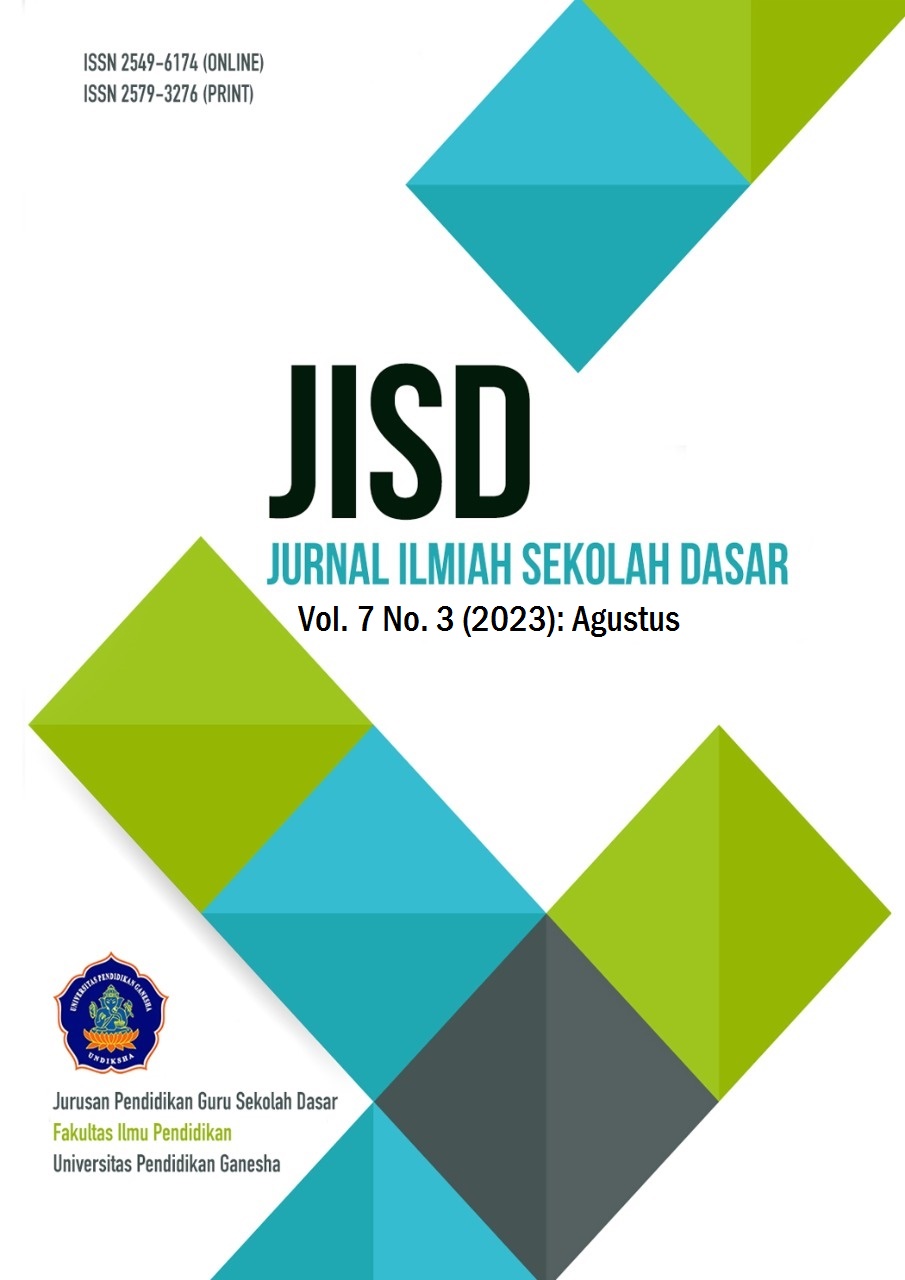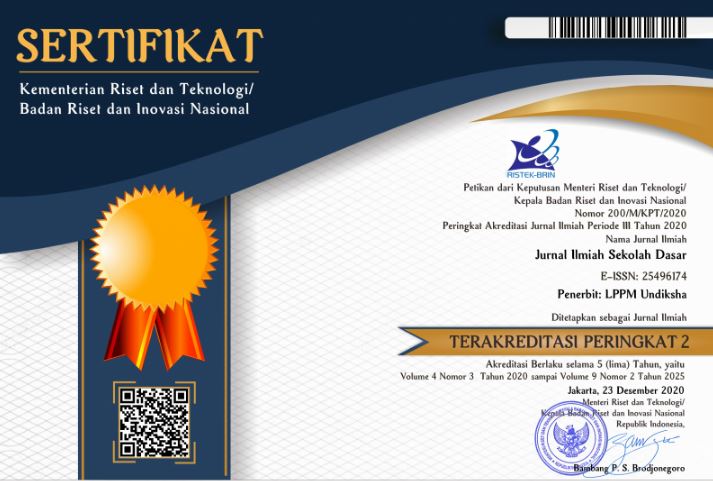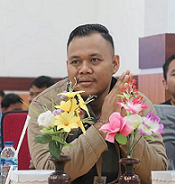Interactive Learning Multimedia in Supporting Personalized Learning Grade V Primary School
DOI:
https://doi.org/10.23887/jisd.v7i3.57784Keywords:
Learning Multimedia, Articulate Storyline, Human Blood Circulation MaterialAbstract
The absence of interactive media and media development in an area shows that adaptation to technology has yet to be maximized. The research aimed to produce interactive multimedia material on human blood circulation for grade V SD and determine its quality and feasibility by conducting validation trials on experts, teachers, and students. This research method is R&D (Research and Development) with the ADDIE model. The subjects in this study were fifth-grade elementary school students. Data collection methods are assessment sheets and documentation. Data collection instrument using a questionnaire. Data analysis techniques are quantitative data analysis and qualitative descriptive data analysis. The results of the research are in the form of interactive multimedia based on storylines of articulation of human blood circulation in science subjects for class V SD which can be used by students with a score of 92.5% from material experts; media experts 86.66%; learning experts 88.88%; linguists 74.26%; teacher assessment 98.88%; Penialain students 93.40%. The scores of each expert, teacher, and student assessment were then searched for the average value and obtained a percentage value of 89.096% with the "Very Good" criterion. It was concluded that the developed multimedia is very good quality, is suitable for use in learning activities, and has personalized learning characteristics that support student-centered learning activities.
References
Ahdhianto, E., Marsigit, Haryanto, & Nurfauzi, Y. (2020). Improving Fifth-Grade Students’ Mathematical Problem-solving and Critical Thinking Skills Using Problem-Based Learning. Universal Journal of Educational Research, 8(5), 2012–2021. https://doi.org/10.13189/ujer.2020.080539. DOI: https://doi.org/10.13189/ujer.2020.080539
Alfiansyah, M. F., Adi, E. P., & Soepriyanto, Y. (2022). Pengembangan Multimedia Interaktif Ipa Dengan Fitur Feedback Untuk Siswa Kelas Viii. JKTP: Jurnal Kajian Teknologi Pendidikan, 5(1), 22–31. https://doi.org/10.17977/um038v5i12022p022. DOI: https://doi.org/10.17977/um038v5i12022p022
Alturise, F. (2020). Difficulties in teaching online with Blackboard learn effects of the COVID-19 pandemic in the western branch colleges of Qassim University. International Journal of Advanced Computer Science and Applications, 11(5), 74–81. https://pdfs.semanticscholar.org/dad1/. DOI: https://doi.org/10.14569/IJACSA.2020.0110512
Andarwulan, T., Al Fajri, T. A., & Damayanti, G. (2021). Elementary teachers’ readiness toward the online learning policy in the new normal era during Covid-19. International Journal of Instruction, 14(3), 771–786. https://doi.org/10.29333/iji.2021.14345a. DOI: https://doi.org/10.29333/iji.2021.14345a
Apriati, L., Mulawarman, W. G., & Ilyas, M. (2021). Pengembangan Bahan Ajar Menyimak Berbasis Multimedia Interaktif pada Pelajaran Tematik dengan Tema “Indahnya Kebersamaan” untuk Siswa Kelas IV Sekolah Dasar. Diglosia: Jurnal Kajian Bahasa, Sastra, Dan Pengajarannya, 4(1), 13–22. https://doi.org/10.30872/diglosia.v4i1.73. DOI: https://doi.org/10.30872/diglosia.v4i1.73
Aprilliyah. (2014). Pengembangan Media Pembelajaran Modul Interaktif Pada Materi Jurnal Khusus Kelas X Akuntansi di SMK Negeri Mojoagung. Jurnal Khusus, 2(2), 1–7. https://jurnalmahasiswa.unesa.ac.id/index.php/35/article/view/9412.
Boyadzhieva, E. (2016). Learner-centered Teaching and Learner Autonomy. Procedia - Social and Behavioral Sciences, 232, 35–40. https://doi.org/10.1016/j.sbspro.2016.10.008. DOI: https://doi.org/10.1016/j.sbspro.2016.10.008
Branch, R. M. (2010). Instructional design: The ADDIE approach. In Instructional Design: The ADDIE Approach. https://doi.org/10.1007/978-0-387-09506-6. DOI: https://doi.org/10.1007/978-0-387-09506-6
Browne, K., Anand, C., & Gosse, E. (2014). Gamification and serious game approaches for adult literacy tablet software. Entertainment Computing, 5(3), 135–146. https://doi.org/10.1016/j.entcom.2014.04.003. DOI: https://doi.org/10.1016/j.entcom.2014.04.003
Bustanil S, M., Asrowi, & Adianto, D. T. (2019). Pengembangan Media Pembelajaran Interaktif Berbasis Video Tutorial Di Sekolah Menengah Kejuruan. JTP - Jurnal Teknologi Pendidikan, 21(2), 119–134. https://doi.org/10.21009/jtp.v21i2.11568. DOI: https://doi.org/10.21009/jtp.v21i2.11568
Fitri, S. F. N. (2021). Problematika Kualitas Pendidikan di Indonesia. Jurnal Pendidikan Tambusai, 5(1), 1617–1620. https://www.jptam.org/index.php/jptam/article/view/1148.
Fitriani, A. D. (2014). Pengembangan Multimedia Interaktif Dalam Pembelajaran Geometri Untuk Meningkatkan Kemampuan Komunikasi Calon Guru Sekolah Dasar. Edutech, 13(2), 236. https://doi.org/10.17509/edutech.v13i2.3105. DOI: https://doi.org/10.17509/edutech.v13i2.3105
Garba, S. A., Byabazaire, Y., & Busthami, A. H. (2015). Toward the use of 21st century teaching-learning approaches: The trend of development in Malaysian schools within the context of Asia Pacific. International Journal of Emerging Technologies in Learning, 10(4), 72–79. https://doi.org/10.3991/ijet.v10i4.4717. DOI: https://doi.org/10.3991/ijet.v10i4.4717
Hanim, Z., Diana, R., Soe’oed, R., & Sallu, S. (2021). Interactive Learning Multimedia Development Using Articulate Storyline 2 on Plant Breeding Course in State Vocational School Loa Janan, East Kalimantan, Indonesia. Psychology and Education Journal, 58(1), 5628–5636. https://doi.org/10.17762/pae.v58i1.2184. DOI: https://doi.org/10.17762/pae.v58i1.2184
Hau, N. H., Cuong, T. V., & Tinh, T. T. (2020). Students and Teachers’ Perspective Of The Importance Of Arts In STEAM Education In Vietnam. Journal of Critical Reviews, 7(11), 666–671. https://doi.org/10.31838/jcr.07.11.121.
Hewi, & Shaleh. (2020). Reflection of PISA (The Program For International Student Assessment) Results: Improvement Efforts Relying on Early Childhood Education. Journal Golden Age, 4(1), 30–41. https://doi.org/10.29408/goldenage.v4i01.2018.
Indriani, S. M., Artika, W. I., & Ningtias, W. R. D. (2021). Penggunaan Aplikasi Articulate Storyline Dalam Pembelajaran Mandiri Teks Negosiasi. Jurnal Pendidikan Bahasa Dan Sastra Indonesia, 11(1), 25–36. https://ejournal.upbatam.ac.id/index.php/cbis/article/view/400.
Liliana, R. A., Raharjo, W., Jauhari, I., & Sulisworo, D. (2020). Effects of the online interactive learning media on student’s achievement and interest in physics. Universal Journal of Educational Research, 8(3 B), 59–68. https://doi.org/10.13189/ujer.2020.081507. DOI: https://doi.org/10.13189/ujer.2020.081507
Maria, U., Rusilowati, A., & Hardyanto, W. (2018). Interactive Multimedia Development in The Learning Process of Indonesian Culture Introduction Theme for 5-6 Year Old Children. Journal of Primary Education, 8(3), 344–353. https://journal.unnes.ac.id/sju/index.php/jpe/article/view/27929.
Nugroho, I. A., & Surjono, H. D. (2019). Pengembangan multimedia pembelajaran interaktif berbasis video materi sikap cinta tanah air dan peduli lingkungan. Jurnal Inovasi Teknologi Pendidikan. https://doi.org/10.21831/jitp.v6i1.15911. DOI: https://doi.org/10.21831/jitp.v6i1.15911
Pratiwi, I. (2019). Efek Program Pisa Terhadap Kurikulum Di Indonesia. Jurnal Pendidikan Dan Kebudayaan, 4(1), 51. https://doi.org/10.24832/jpnk.v4i1.1157. DOI: https://doi.org/10.24832/jpnk.v4i1.1157
Qekaj-Thaqi, A., & Thaqi, L. (2021). The Importance of Information and Communication Technologies (ICT) during the COVID-19—Pandemic in Case of Kosovo (Analytical Approach of Students Perspective). OALib, 08(07), 1–15. https://doi.org/10.4236/oalib.1106996. DOI: https://doi.org/10.4236/oalib.1106996
Rahmawati, Z. D. (2020). Penggunaan Media Gadget Dalam Aktivitas Belajar Dan Pengaruhnya Terhadap Perilaku Anak. TA’LIM : Jurnal Studi Pendidikan Islam, 3(1), 97–113. https://doi.org/10.52166/talim.v3i1.1910. DOI: https://doi.org/10.52166/talim.v3i1.1910
Rohmah, F. N., & Bukhori, I. (2020). Pengembangan Media Pembelajaran Interaktif Mata Pelajaran Korespondensi Berbasis Android Menggunakan Articulate Storyline 3. ECOEDUCATION (Economic & Education Journal), 2(2), 169–182. https://doi.org/10.33503/ecoducation.v2i2.892. DOI: https://doi.org/10.33503/ecoducation.v2i2.892
Saripudin, D., Komalasari, K., & Anggraini, D. N. (2021). Value-Based Digital Storytelling Learning Media to Foster Student Character. International Journal of Instruction, 14(2), 369–384. https://doi.org/10.29333/iji.2021.14221a. DOI: https://doi.org/10.29333/iji.2021.14221a
Septiana, I. G. Y., Wibawa, I. M. C., Ayu, G., & Sukma, P. (2022). Interactive Multimedia Based on Articulate Storylines in the Topic of Plant Anatomy and Physiology. International Journal of Elementary Education, 6(2), 182–194. https://doi.org/https://doi.org/10.23887/ijee.v6i2.46486.
Setiyawan, H. (2021). Pemanfaatan Media Audio Visual dan Media Gambar Pada Siswa Kelas V. Jurnal Prakarsa Paedagogia, 3(2). https://doi.org/10.24176/jpp.v3i2.5874. DOI: https://doi.org/10.24176/jpp.v3i2.5874
Setyoningsih. (2015). E Learning : Pembelajaran Interaktif Berbasis Teknologi. Elementary, 3(1), 39–58. https://doi.org/http://dx.doi.org/10.21043/elementary.v3i1.1443.
Shahroom, A. A., & Hussin, N. (2018). Industrial Revolution 4.0 and Education. International Journal of Academic Research in Business and Social Sciences, 8(9). https://doi.org/10.6007/ijarbss/v8-i9/4593. DOI: https://doi.org/10.6007/IJARBSS/v8-i9/4593
Solikah, M., & Novita, D. (2022). The effectiveness of the guided inquiries learning model on the critical thinking ability of students. Jurnal Pijar Mipa, 17(2), 184–191. https://doi.org/10.29303/jpm.v17i2.3276. DOI: https://doi.org/10.29303/jpm.v17i2.3276
Subekti, H. A., Nubaiti, N., Masilawati, M., & Fitria, H. (2020). Pemanfaatan Video Conference Sebagai Media Pembelajaran Interaktif pada Mata Pelajaran Produktif di Sekolah Menengah Kejuruan. Prosiding Seminar Nasional Program Pascasarjana Universitas PGRI Palembang, 427–437. https://core.ac.uk/download/pdf/322573925.pdf.
Suharman, F., Utami, R., & Dewi, T. M. (2020). Pengembangan Media Modul Pembelajaran Tematik Tema Cuaca Subtema Perubahan Cuaca Untuk Siswa Kelas III SD. Jurnal Pendidikan MINDA, 1(2), 1–9. http://ejurnal.universitaskarimun.ac.id/index.php/mindafkip/article/view/118.
Susilowati, W. W., & Suyatno, S. (2021). Teacher competence in implementing higher-order thinking skills oriented learning in elementary schools. Premiere Educandum : Jurnal Pendidikan Dasar Dan Pembelajaran. https://doi.org/10.25273/pe.v11i1.7762. DOI: https://doi.org/10.25273/pe.v11i1.7762
Tsaniyah, N., & Juliana, K. A. (2019). Literasi Digital Sebagai Upaya Menangkal Hoaks Di Era Disrupsi. Al-Balagh : Jurnal Dakwah Dan Komunikasi, 4(1), 121–140. https://doi.org/10.22515/balagh.v4i1.1555. DOI: https://doi.org/10.22515/balagh.v4i1.1555
Vastyanov, R., Yermuraki, P., Stoyanov, A., Tiron, O., Beseda, Y., Ostapenko, I., Dobrovolsky, V., Lapshin, D., & Stecenko, A. (2021). New aspects of pedagogical activity in the distant form of pathological physiology teaching to medical university students. Journal of Education, Health and Sport, 11(10), 173–186. https://doi.org/10.12775/jehs.2021.11.10.015. DOI: https://doi.org/10.12775/JEHS.2021.11.10.015
Widyastuti, E. (2019). Using the ADDIE model to develop learning material for actuarial mathematics. In Journal of Physics: Conference Series, 1188(1), 012052. https://doi.org/10.1088/1742-6596/1188/1/012052. DOI: https://doi.org/10.1088/1742-6596/1188/1/012052
Winarto, W., Syahid, A., & Saguni, F. (2020). Effectiveness the Use of Audio Visual Media in Teaching Islamic Religious Education. International Journal of Contemporary Islamic Education, 2(1), 81–107. https://doi.org/10.24239/ijcied.Vol2.Iss1.14. DOI: https://doi.org/10.24239/ijcied.Vol2.Iss1.14
Downloads
Published
How to Cite
Issue
Section
License
Copyright (c) 2023 Lovandri Dwanda Putra

This work is licensed under a Creative Commons Attribution-ShareAlike 4.0 International License.
Authors who publish with the Journal Ilmiah Sekolah Dasar agree to the following terms:
- Authors retain copyright and grant the journal the right of first publication with the work simultaneously licensed under a Creative Commons Attribution License (CC BY-SA 4.0) that allows others to share the work with an acknowledgment of the work's authorship and initial publication in this journal.
- Authors are able to enter into separate, additional contractual arrangements for the non-exclusive distribution of the journal's published version of the work (e.g., post it to an institutional repository or publish it in a book), with an acknowledgment of its initial publication in this journal.
- Authors are permitted and encouraged to post their work online (e.g., in institutional repositories or on their website) prior to and during the submission process, as it can lead to productive exchanges, as well as earlier and greater citation of published work. (See The Effect of Open Access)










